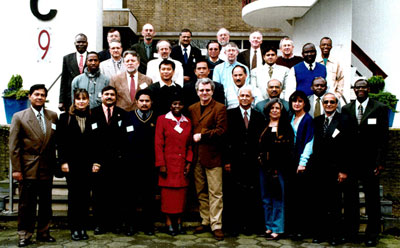News
Nutrition International works to sustainably expand fortification for edible oil and wheat flour in Pakistan
February 15, 2023
Reducing micronutrient deficiencies by training global Food Fortification Consultants
The Micronutrient Initiative and the International Agriculture Centre organized the first Food Fortification Technical Experts' Training Course in Wageningen, Netherlands in March 2002.
Posted on June 15, 2011


To offer intensive training on food fortification processes – that was the Micronutrient Initiative’s (MI) and the International Agriculture Centre’s (IAC) joint purpose when they organized the first Food Fortification Technical Experts’ Training Course in Wageningen, Netherlands in March 2002.
The nine-day course included 25 participants who were carefully selected to provide diverse regional expertise, technical and linguistic skills and a wide range of educational and work backgrounds in food science and technology, nutrition, public health, communications and social marketing.
“MI and the IAC brought 25 fortification experts together to foster knowledge and peer-to-peer exchanges, and create a network of consultants that could provide much-needed guidance for fortification projects around the world.”
Venkatesh Mannar
The training included lectures on essential technical information about micronutrient nutrition, staple food fortification processes and principles of fortification program design.
Students also worked on the resolution of a country case (for India, South Africa or Brazil), where they made decisions related to the food to be fortified in the country, the micronutrients to be used and the preparation of an implementation plan.
The program also included site visits to a mixing equipment manufacturing facility and to Unilever’s research facility. This component provided participants with invaluable hands-on experience to help them in their future roles as food fortification consultants.
The session not only expanded the global pool of technical food fortification experts, but also created a network of specialists that has surpassed national boundaries.
Mannar explained: “Network members have since shared their expertise and supported each other, MI, the IAC and the partner agencies and governments they work with to deliver many successful food fortification programs in developing countries.”
Many of the course’s participants have since done invaluable work on fortification initiatives that has helped ensure fortified foods are now being produced in developing nations.
For example, participant Vinod Kapoor (top row, fourth from the left) started the India Flour Fortification Initiative (IFFN).
He was instrumental in initiating dialogue with millers and millers’ associations in India and in advocating for flour fortification at annual meetings with flour millers.
In 2010, the IFFN’s efforts resulted in a pilot introduction of wheat flour fortification in the public distribution systems in Rajasthan, Madhya Pradesh and Bihar and training of mill owners and government officials on flour fortification. The IFFN also assisted state governments in finalizing flour fortification standards. A Monitoring and Evaluation framework in India is currently being developed.
Isiaka Alo (second row, immediate left) returned to Nigeria and initiated a government policy mandating fortification of all flours, cooking oils and salt.
Because of his vital work and that of many others, in 2007, over 12 million children under the age of five and women of child-bearing age consumed wheat flour and maize flour fortified with vitamin A.
Today, approximately 30 million Nigerians consume 262 tons of vitamin A-fortified vegetable oil daily and 97 million Nigerians consume 825,000 MT of sugar fortified with vitamin A each year.
After attending the course, Majid Abdullah (second row, second from the right) went back to Pakistan and was indispensible in helping to prepare Pakistan’s detailed flour fortification plan.
He successfully procured three million dollars in funding from GAIN and one million dollars from MI. Today, through his hard work and that of many others, 25 per cent of the flour in Pakistan is fortified and reaches 40 million people.
Mohammad Rahmani (second row, third from the right) returned to Morocco and advocated for the fortification of all cooking oils with vitamin A.
Today, in part because of his tireless efforts, the country’s vitamin A program reaches almost 100% of the population and has been extremely effective in reducing vitamin A deficiency.
“The Food Fortification Technical Expert’s Training Course reminded each participant of the wealth of knowledge that exists within their community and the value of connecting with each other, rather than working in isolation,” said Mannar. “By developing this network, MI has created a platform that operates much like a school where each member shares their knowledge and produces unique lessons that benefit the other members; ultimately, these lessons benefit the most vulnerable who suffer from micronutrient deficiencies the most.”
Given the growing importance of food fortification in countries around the world and the need for experts who can establish sustainable programs, MI will continue to offer training for consultants, program managers and industry managers on fortification program development and management in future.